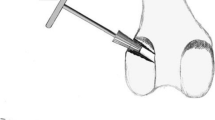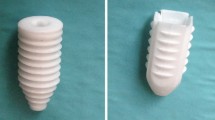Summary
The endoscopic single incision technique for ACL reconstruction with a femoral half-tunnel may lead to a graft/tunnel mismatch and subsequent protrusion of the block from the tibial tunnel. The typical tibial fixation with an interference screw is not possible in these cases. Fixation with staples in a bony groove inferior to the tunnel outlet can be used as an alternative technique. Current literature does not provide biomechanical data of both fixation techniques in a human model. This study was performed to evaluate primary biomechanical parameters of this technique compared to a standard interference screw fixation of the block. 55 fresh-frozen human cadaver knee joints of a younger age (mean age: 44 years) were used. Grafts were harvested from the patellar tendon midportion with bone blocks of 25 mm length and 9 mm width. A 10 mm tibial tunnel was drilled from the anteromedial cortex to the center of the tibial insertion of the ACL. 3 different sizes of interference screws (7 × 30, 9 × 20 and 9 × 30 mm) were chosen as a standard control procedure (n = 40). For tibial bone-block fixation the graft was placed through the tunnel, the screw was then inserted on the cancellous or the cortical surface respectively. 15 knees were used for staple fixation. A groove was created inferior to the tunnel outlet with a chisel. The bone block was fixed in this groove with 2 barbed stainless steel staples. Tensile testing in both of the groups was carried out under axial load parallel to the tibial tunnel in a Zwick-testing-machine with a velocity of 1 mm/sec. Dislocation of the graft and stiffness were calculated at 175 N load. Maximum load to failure using interference screws varied between 506 and 758 N. Load to failure using staples was 588 N. Dislocation of the graft ranged between 3.6 and 4.7 mm for interference screw fixation and was 4.2 mm for staples. With both fixation techniques, the recorded failure loads were sufficient to withstand the graft loads which are to be expected during the rehabilitation period. Staple fixation of the bone block outside of the tunnel resulted in fixation strength comparable to interference screw fixation.
Zusammenfassung
Der endoskopische Ersatz des vorderen Kreuzbands (VKB) mit einem Patellarsehnentransplantat in einem femoralen Halbtunnel kann dazu führen, daß der tibiale Block außerhalb des Kanals zu liegen kommt. Ist in diesen Fällen eine Fixation mit Interferenzschrauben nicht möglich, kann die Verankerung des Blockes mit Staples in einer knöchernen Grube distal des Tunnels alternativ durchgeführt werden. In dieser Studie evaluierten wir die biomechanischen Parameter der Interferenzschrauben- und Stapletechnik. Patellarsehnentransplantate wurden in typischer Technik bei 55 frischen humanen Kniegelenken entnommen und auf eine Länge von 25 mm mit einem Durchmesser von 9 mm präpariert. Der tibiale Kanal wurde von anteromedial mit einem 10-mm-Bohrer zum Ansatz des VKB angelegt; 40 Präparate wurden für die Fixation mit 3 verschieden großen Interferenzschrauben (7 × 30, 9 × 20 und 9 × 30 mm) als Referenzverfahren und 15 weitere Präparate für die Fixation mit Staples verwendet. Hierzu wurde eine knöcherne Grube unterhalb des tibialen Tunnels angelegt, in der das Transplantat mit 2 Staples befestigt wurde. Die Krafteinleitung erfolgte axial zum tibialen Tunnel mit einer Geschwindigkeit von 1 mm/s auf einer Zwick-Materialprüfmaschine. Die Dislokation des Transplantats und die daraus abgeleitete Steifigkeit wurden bei 175 N Last angegeben. Bei der Fixation mit Interferenzschrauben fanden wir eine Variation der maximalen Zuglast in Abhängigkeit von der Schraubengröße zwischen 506 und 758 N. Staples wiesen eine maximale Zuglast von 588 N auf. Die Dislokation gemessen bei 175 N Last variierte bei der Schraubenfixation zwischen 3,6 und 4,7 mm und betrug bei der Fixation mit Staples 4,2 mm. Bei allen Fixationsmethoden waren die maximalen Zuglasten bis zum Transplantatversagen ausreichend, um den Lastspitzen während der Rehabilitationsphase zu widerstehen. Die in der Fixierung mit Staples erreichten Werte waren mit der Ausreißkraft der Interferenzschrauben zu vergleichen. Eine Verankerung mit Staples kann daher als eine sichere alternative Methode für die Transplantatfixierung angesehen werden.
Similar content being viewed by others
Author information
Authors and Affiliations
Rights and permissions
About this article
Cite this article
Gerich, T., Cassim, A., Lattermann, C. et al. Pullout strength of tibial graft fixation in ACL-replacement with a patellar tendon graft: Interference screw versus staple fixation in human knees. Unfallchirurg 101, 204–208 (1998). https://doi.org/10.1007/s001130050255
Published:
Issue Date:
DOI: https://doi.org/10.1007/s001130050255




